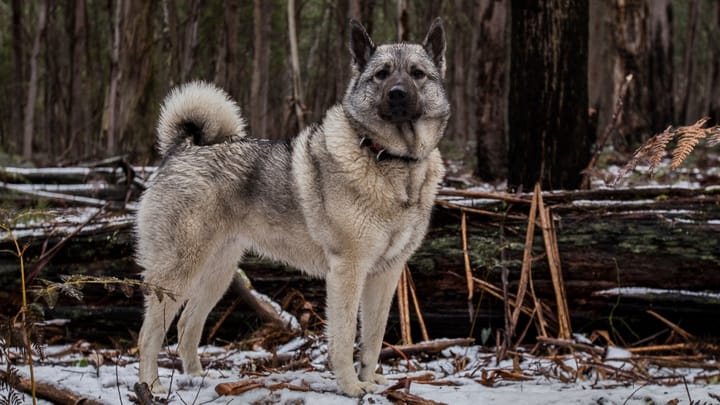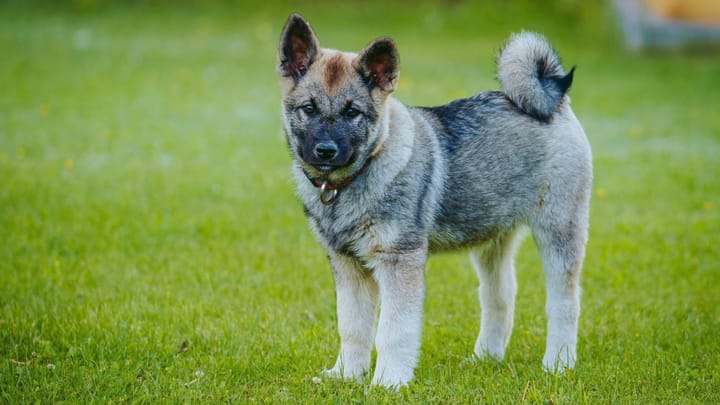Norwegian Elkhound Grey
Other names : Norwegian Moose Dog, Grey Elk Dog, Norskelghund, Grå norsk elghund, Gray Norwegian Elkhound, Small Grey Elk Dog, Harmaa norjanhirvikoira, Norwegian Elkhound


The Norwegian Elkhound is an ancient spitz breed. The national dog of Norway, the Elkhound is a revered and skillful hunting dog. A brave and fearless animal, they’re used to track moose, bears, elk, and even wolves. This dog is exceptionally loyal and tends to form a close bond with one member of the family. Thanks to its sharp (and very loud) bark, the Elkhound also makes an excellent watchdog.
|
Life expectancy |
The Norwegian Elkhound Grey has a life expectancy of between 12 and 14 years |
|
Temperament |
|
|
Size |
Medium
|
|
Adult size |
Female
Between 17 and 18 in
Male
Between 18 and 19 in
|
|
Adult weight |
Female
Between 44 and 55 lb
Male
Between 44 and 55 lb
|
|
Coat colour
Grey and dark grey. |
Blue |
|
Type of coat
Harsh, straight topcoat. Soft and dense undercoat. |
Long Hard |
|
Eye colour
Brown. |
Brown
|
|
Purchase price |
The Norwegian Elkhound Grey costs between £1000 and £1500 |
Young Elkhounds are very boisterous, and as puppies, they border on the hyperactive. They need a tremendous amount of exercise and stimulation.
Elkhounds love cold weather, especially the snow.
The Elkhound can be very stubborn and disobedient. They can run rings around less experienced dog handlers.
More details about the Norwegian Elkhound Grey
Norwegian Elkhound Grey: Origins and history
The Norwegian Elkhound is an ancient breed that was developed around 3,000 years ago. It’s a result of a female wolf and male dog hybridization that occured long after wild wolves were first domesticated. It seems that Scandinavian tribes were looking for a way to improve the existing hunting breeds by crossing them with wolves. And they certainly succeeded with the Norwegian Elkhound. This dog has been hunting alongside humans ever since and still helps hunters track large game such as moose, elk, and bears. This highly prized dog was rarely seen outside of Norway until the late 19th Century. It was officially recognised by the Kennel Club in 1901.
Physical characteristics of the Norwegian Elkhound Grey
Medium sized spitz breed. Sturdy build with a square body and large head. Thick fur and bushy tail. Alert, intelligent expression. Elongated muzzle.
FCI classification of the Norwegian Elkhound Grey
-
Group 5 - Spitz and primitive types
-
Section 2 : Nordic Hunting Dogs
Norwegian Elkhound Grey: Characteristics
Norwegian Elkhound Grey: Behaviour
Training a Norwegian Elkhound Grey
Responds well to reward-based training methods, but requires a firm and confident handler. Consistency and structure are really important when training these highly-intelligent animals.
Norwegian Elkhound Grey: Lifestyle
Breed compatibility Norwegian Elkhound Grey
Norwegian Elkhound Grey: Purchase price
The initial cost of a Norwegian Elkhound puppy is between £1,000 to £1,500. The average cost to keep one of these dogs (including vet bills, insurance, and food) is between £50 to £100 a month.
Norwegian Elkhound Grey: Shedding
Average
Sheds throughout the year. Very heavy shedding during the Spring.
Norwegian Elkhound Grey: Grooming
The Elkhound has a thick, profuse coat that needs brushing on a weekly basis.
Norwegian Elkhound Grey: Health
A very healthy and well-bred dog, although they do have a genetic predisposition to thyroid problems. Their average life expectancy is between 12 and 14 years.
Bred to survive in harsh natural environments. Very strong. Very robust. Well-built, muscular dog with lots of stamina.
Sheds during the spring, which helps keep them cool in summer. However, they will struggle in warmer countries, especially during very hot summers.
They have a thick, double-layered coat that provides protection against the cold, the rain, and the wind. No problems surviving the cold.
Although the Elkhound has an average appetite, they’re prone to rapid weight-gain as they approach old age. This is due to problems with their thyroid gland, which slows down the Elkhounds metabolism.
- Hip dysplasia
- Elbow dysplasia
- Thyroid problems
- Cysts
- Progressive Retinal Atrophy
- Rapid weight gain
Do you want a Norwegian Elkhound Grey dog ?
Oh no...
There are no Norwegian Elkhound Grey adoption profiles at the moment...



